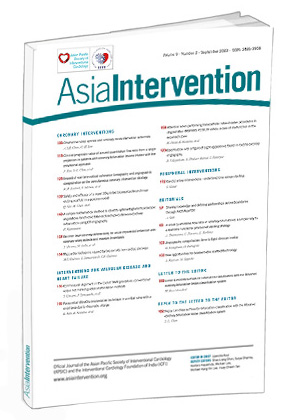Bioresorbable scaffolds (BRS) are an attractive treatment option for coronary artery disease due to their unique property of complete degradation after implantation, potentially reducing complications associated with residual struts in the vessel wall. However, the results of clinical trials have been disappointing, demonstrating an increased risk of scaffold thrombosis and restenosis12. Despite this setback, research and development efforts to improve the safety and efficacy of BRS continue, with a focus on several directions including strut thickness and scaffold material3. Another promising option may be to modify the strut shape to round struts, which has the potential to improve the blood flow characteristics in coronary arteries.
Three-dimensional (3D) printing technology has made remarkable progress in recent years and is widely used in the development of novel medical devices. This technology allows for flexible scaffold manufacturing, enabling the customisation of devices with varying strut thicknesses, shapes and architecture. In this issue of AsiaIntervention, Shi et al share the results of a preclinical study comparing the performance of a newly developed polymeric sirolimus-eluting BRS (AMSorb; Beijing Advanced Medical Technologies) manufactured using 3D printing technology with a sirolimus-eluting metallic stent (SES; HELIOS [Kinhely Medical])4. The AMSorb scaffold has a poly-L-lactic acid (PLLA) backbone coated with a mixture of an amorphous matrix of poly (D, L-lactic acid) and sirolimus. The struts of the BRS have a circular shape with a thickness of 140 μm. The control device (an SES) was a metallic stent consisting of an 80 μm-thick cobalt-chromium alloy coated with sirolimus and polylactic-co-glycolic acid. A total of 32 BRS and 32 SES were implanted in 32 porcine coronary arteries in the present study. A comprehensive assessment, including angiography, optical coherence tomography (OCT) and histopathology, was performed to compare the performance of the study devices at 14, 28, 97, and 189 days after implantation.
Despite the quality of this study, there are some limitations. Previous experience with BRS using the same material used in this study has shown that complete polymer resorption takes >3 years. A longer follow-up and a dedicated OCT methodology would have allowed the evaluation of this process for AMSorb. In addition, the specific advantages of the 3D printing technology and the round strut shape are best evaluated with an additional control group using conventional BRS. Furthermore, the histopathological examination did not include an evaluation of fibrin deposition in the 2 study groups. Finally, scaffold discontinuity, a potentially important correlate of late thrombosis56, was not assessed in this study.
Overall, the present study showed satisfactory results with this novel BRS. OCT at 14 and 28 days after implantation showed significantly smaller lumen and stent areas for the AMSorb scaffold compared to the SES. However, at 97 and 189 days, no significant differences were found between the 2 devices. Quantitative coronary angiography analysis showed no significant differences in late lumen loss at any time point. Histopathological examination showed comparable levels of injury, inflammation and endothelialisation for BRS and SES. Based on these findings, the authors concluded that the safety and efficacy of this particular 3D-printed BRS in a porcine model are comparable to those observed with SES.
The absence of an Absorb (Abbott) control group in this study4 means that only indirect comparisons can be made. In a previous porcine model, Absorb showed a higher injury score at 12 months and more pronounced inflammation only at ≥6 months post-implantation compared to metallic drug-eluting stents7. Therefore, the lack of increased injury score and inflammation with the novel device evaluated in the present study may well be related to the shorter study period, although a positive contribution from the rounded shape of the struts is also plausible4.
It is well known that thicker struts increase coronary flow separation and stagnation, thereby enhancing platelet deposition and thrombin and fibrin generation8. However, it is very unlikely that the small difference in strut thickness between AMSorb and Absorb (<20 μm) makes a relevant difference in this regard. Previous in vitro research has shown that not only greater strut thickness but also rectangular strut geometry disturbs the local flow field creating peristrut recirculation zones with longer blood particle residence times and increased thrombus formation9. Round struts were associated with reduced recirculation zones and fibrin deposition and increased expression of protective endothelial thrombomodulin9. Therefore, the round struts created by the 3D printing technology may also partly explain the good results observed in the present study4. AMSorb was associated with a similar degree of endothelialisation to that seen in the metallic DES group4. Although it is possible that the strut shape and thickness of this device contributed to this result, endothelialisation was also not affected by device type (Absorb or XIENCE [Abbott]) in a previous animal study7.
In conclusion, the present porcine model study used a multifaceted evaluation methodology, including angiography, OCT and histopathology, and showed very encouraging results with a novel BRS based on 3D printing technology. This technology should probably be incorporated in the effort to create BRS with thinner and improved strut shapes, with greater chances of a safer and more effective device for clinical practice. However, a look at the past shows that even with the Absorb scaffold, preclinical results were encouraging enough to justify the start of clinical trials. The challenging question is which preclinical evaluation method is more likely to avoid the kind of disappointment that we have seen in clinical practice with older polymer-based and fully resorbable scaffolds. The work of Shi and colleagues4 has shown that this technology may have a new lease of life, provided that it is carefully evaluated and that the lessons of the past are taken into account.
Conflict of interest statement
A. Kastrati is one of the inventors of a patent application from his institution related to drug-eluting stent technology. M. Seguchi has no conflicts of interest to declare.

